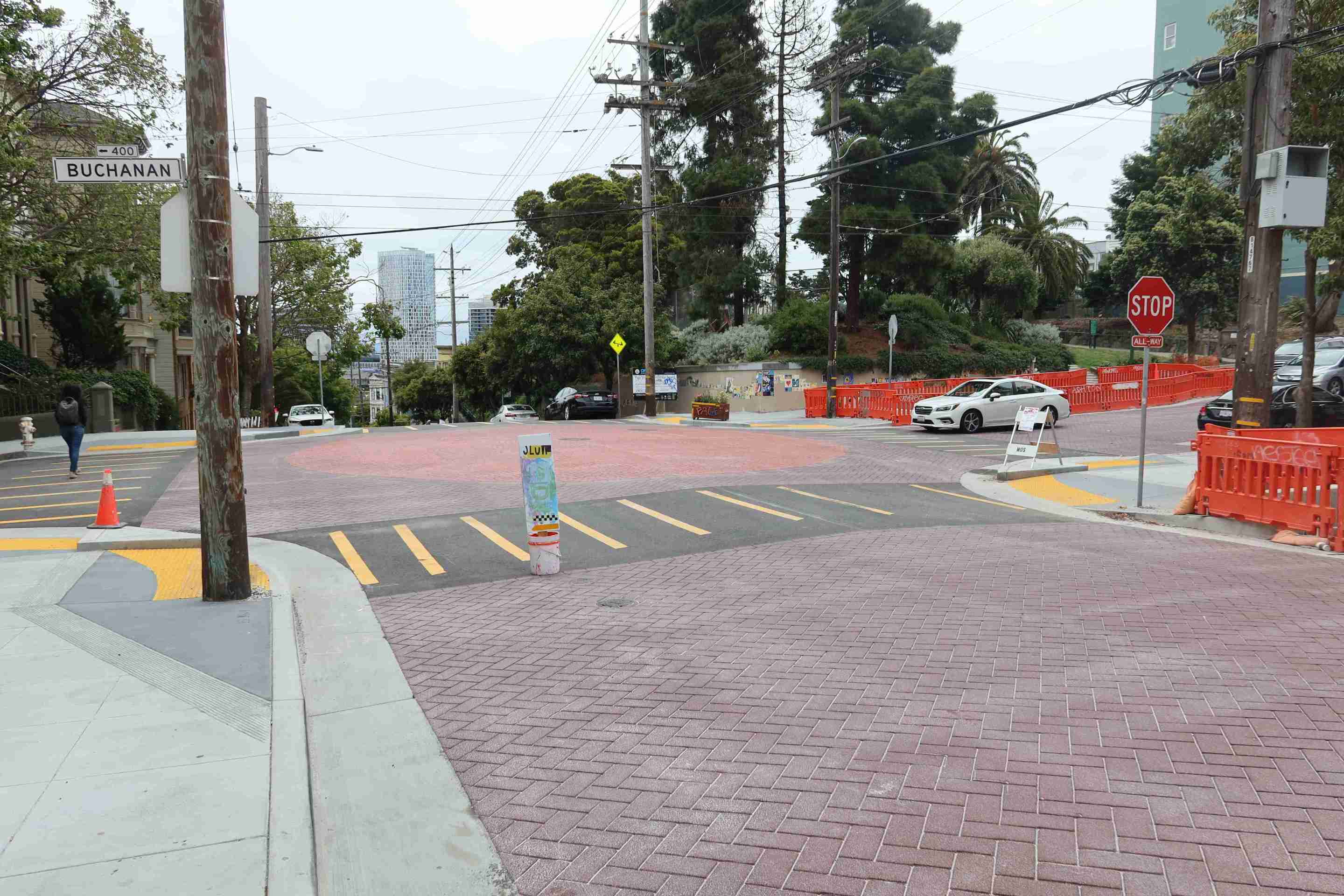The marquee component of the Page Street Neighborhood Way project was supposed to be the city's first raised intersection, also known as a speed table, planned for Page and Buchanan. In this configuration, pictured below in a rendering, the entire intersection is kept at sidewalk level to force motorists to slow down as they cross. Note the minimal curb at the corners.

The above rendering of the raised intersection, promised in 2018 by SFMTA, looks similar to the lead photo of what was actually completed this week. However, the actual constructed intersection has ramps that lead pedestrians down to street level, because the crosswalks and intersection aren't raised.
"It is attractive, but certainly not San Francisco's first 'raised intersection' Walk SF and the community fought for," wrote Walk San Francisco's Jodie Medeiros in an email to Streetsblog about the recently completed project. "This intersection treatment doesn't meet design standards with the intersection raised to the height of the sidewalk."
This is beautiful but without raised crosswalks or an island in the center it'll do absolutely nothing to improve safety and slow drivers down. https://t.co/RhiL7FJJdi
— Stephen Braitsch @braitsch@sfba.social (@braitsch) June 7, 2023
The city also built rain gardens and new curbs and ramps. The overall project started planning almost a decade ago and the raised intersection was approved in 2020.
Streetsblog reached out to SFMTA to try and get an official explanation for why the raised intersection/crosswalks were omitted and will update this post. However, advocates forwarded a 2022 email from an SFMTA official. "There were a series of design decisions made (many about accessibility) that made it difficult to make the intersection design feel and look sidewalk-level," wrote the official. "Further, the approaching streets have significant slopes, so the flat intersection was complex to mold into a raised surface."
From Streetsblog's view, that's a lame answer. Sure, safety features are sometimes "complex to mold." Streets are complex things. Nobody ever said achieving Vision Zero would be easy.
Advocate and writer Jason Henderson, who lives in the area and toured the intersection Wednesday, told Streetsblog that Buchanan has become a favorite cut-through alternative to Octavia for motorists coming to and from the freeway. A speed table would have helped deter motorists from speeding down neighborhood streets. Unfortunately, this project--as with many others--has taken so long to construct that many advocates just lost track of it, to the point that the removal of the raised intersection went more or less unnoticed. "We approved this years ago, and nobody remembers it."

"It's unclear that the city knows how to implement a raised intersection that provides traffic-calming," opined Jessica Jenkins with Page Slow Street. Moreover, in addition, she said "slow street" signs have been neglected up and down the project. "This has been very discouraging because there is a public elementary school, playground, two community gardens, and public housing with many families," she wrote in an email to Streetsblog, highlighting the lack of infrastructure at Buchanan and Laguna in particular. "The speed data collected by SFMTA recently shows that these blocks lacking slow street signage have some of the highest speeds on Page."
"This work--which was intended to increase safety and slow motorists--has been watered down to a costly and much less effective piece of art that took much more time to be installed than it should have," wrote advocate Luke Bornheimer, also in an email to Streetsblog, of the brick treatment on Buchanan. "A stamped piece of asphalt won't make our streets significantly safer or help us fight climate change."
Streetsblog also reached out to Supervisor Dean Preston's office but received no reply by publication time.
Update: an official in Dean Preston's office explained that the center of the intersection (but not the crosswalks) was raised "another 3 inches or so. The SFMTA has let us know that early observations and feedback is that it is more noticeably traffic-calmed than before."
The official also forwarded this from SFMTA's Casey Hildreth: "The raised portion of the raised intersection is indeed a disappointment and we will take several lessons learned from it. First and foremost, it was a struggle to get Public Works disability coordinator on board for a truly 'flush' pedestrian environment that doesn't have curb ramps, so the design looks too much like a normal intersection. Secondly, PW was reluctant to design steeper sloped approaches to the intersection - in part based on numerous complaints from the Fire Department about the nearby Page/Pierce raised crosswalk. Thirdly, there are site conditions (existing slopes and driveways) that further constrained the final design. In the end we should have probably pushed harder in the design process for something better or nixed the raising altogether once it was clear what was designed. I take the blame for not recognizing this sooner."





